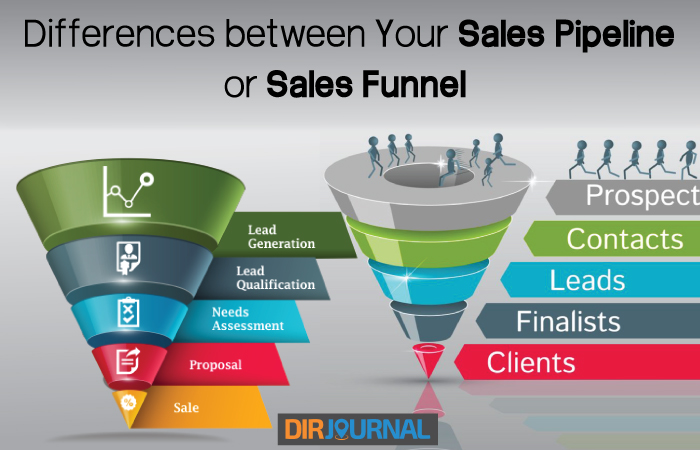You say you’re in sales but you don’t know the difference between a sales pipeline and a sales funnel?
The sales pipeline and funnel don’t look the same to begin with.
The sales pipeline refers to a collection of processes enacted by sales people.
The sales funnel is a collection of behavioral processes associated with prospects or customers.
Shape and function are only two of the dissimilarities between these two systems. A lot more science lies behind both.
The Sales Pipeline
The sales pipeline is defined by a series of sales processes, which may vary between companies but should align with the journey taken by prospects in the sales funnel. No matter the number of steps or what these are named, the fundamental requirements of B2B or B2C selling stays the same.

Step 1 – Prospecting
Start with the Ideal Customer Profile (ICP) based on recorded sales. These are prospects who have been customers before, and need to be persuaded to make more purchases based on your offering and their need fulfillment.
Step 2 – Qualification
Be smart. This is the step where you match your ICP with new prospects who are in the sales pipeline. If they don’t meet your criteria based on predetermined, tried and tested questions, then you need to move on. Pertinent questions would be along the lines of, have you used this product previously? What problem does this solve for you? Company size? Urgency of solution required?
Step 3 – Consideration
The prospective customer has answered the qualifying questions in the affirmative and is now weighing the options. They are probably also checking out competitor products following your sales team’s informative knowledge offerings. This is the time when interest is captured, but also needs to be maintained. Not always an easy task.
Step 4 – Decision
Once the decision has been made by the primary authority, you need to recheck that they really do have the final say and the budget to sign on the dotted line. If not, all that work may cause the sale to be deferred or worse, lost. Now is the time to step up the sales technique to capture a successful close.
Step 5 – Close / Won
The final step of the sales pipeline is closing the deal, signing the contract, delivering the product and post-sales services. Extra customer care at this point translates into referrals and fans for you and your company.
Successfully managing your sales pipeline
A well-defined sales pipeline is essential for understanding each point at which prospects are in the sales funnel. Knowing this status improves understanding of the sales technique to use at that step. Comprehension of this fact, requires specific sales representative training so that they are equipped to identify and apply the appropriate methods at the right time.
CRM sales pipeline metrics
Collecting and recording data, enables data measurement and analysis. Analysis leads to precise improvements at each step in the pipeline. Improvements lead to progress and successful business decisions.
Moving on, we can now look at the sales funnel.
The Sales Funnel
The customers behavioral processes make up the sales funnel. This funnel begins with a wide mouth at the top, which is where many prospective customers may be drawn into the sales funnel and subject to the integrated sales pipeline processes.
The sales funnel is the customer’s purchasing journey, which is aligned with the sales pipeline. These stages typically vary but the basics are found in these steps:
Awareness
Use lead magnets such as gifts to create awareness. Paid marketing is also used to attract attention at the top of the sales funnel.
Interest
Product awareness generates interest. Sustained information sharing is useful at this stage, so a diverse set of sales techniques need to be applied here. Personalized email series, testimonial and case study sharing become the means to build trust and demonstrate brand credibility.
Evaluation
CRM software and data are vital at every step in the sales pipeline and the sales funnel. This step delivers the opportunity for personalized relationship building online, the chance to exercise sales techniques that highlight your understanding of the prospect’s problems, and how your product will solve these.
Engagement
Never assume that the lead has been won until the money is in the bank. Even then, sales people tend to think their job is done. It isn’t. Now is the time to nurture and grow that relationship into a permanent one by continued support, assurance of your commitment and a mutually beneficial alignment of priorities.
Purchase
Once the sale is done, you should practically be on first name terms. Now is the moment to improve your CRM by sending out surveys and for your sales representatives to maintain customer relationships with follow-up emails to determine the end-user’s total experience and touch points. This is also the time to leverage the free marketing opportunity provided by happy customers who want to refer others, share their testimonials and become your company’s fans.
Managing your sales funnel
The same reason you need a distinct sales pipeline and process at each stage, also applies to the sales funnel. Understanding of the customer decision-making process is necessary in knowing what sales techniques to apply at each stage.
This understanding will help to move your prospects from a vague awareness of your product, to being fully-informed, delighted purchasing customers who want to tell everyone about how wonderful you and your company are.
You therefore need a sales funnel that aligns with your sales pipeline processes for record-keeping and conversion in every stage, and to know when, where and what improvements need to be achieved.
CRM sales funnel metrics
Again, the reality of record-keeping in CRM equates to many opportunities to refine and align processes within the sales funnel, just as it does in the sales pipeline. Having these figures ensures alignment of sales goals and tactics with your vision, enhancing the potential for growth and success.
